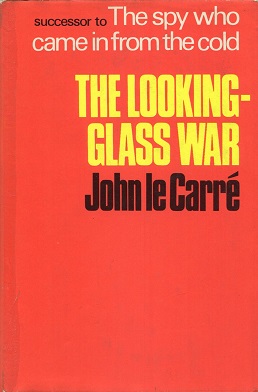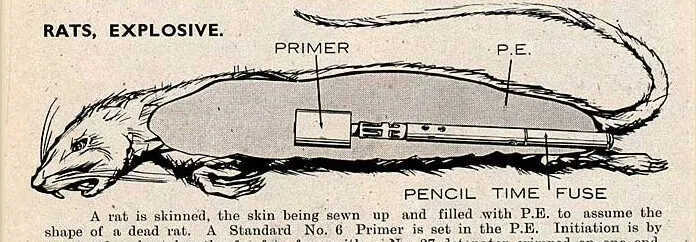‘Amateur, dangerous and bogus’: SIS-SOE relations
Guy Woodward explores social media posts by the outgoing head of SIS and considers the fractious wartime relations between the agency and SOE
Posting on X in July this year Sir Richard Moore, head of the Secret Intelligence Service (SIS, otherwise known as MI6), marked the founding of the SOE eighty-five years ago:

Moore, whose five-year term as ‘C’ ends today, drew a direct parallel between SOE’s support for resistance groups in occupied Europe during the Second World War and SIS’s covert assistance to Ukraine as it resists continuing attacks by Russia. The possible nature of this assistance is clearly intriguing, but Moore’s suggestion that SIS was the SOE’s ‘proud ancestor’ also raised eyebrows. Posting in response Peter Hitchens, the Mail on Sunday columnist, observed that Moore had presumably not read John le Carré’s novel The Looking Glass War (1965) which addressed ‘the tragic delusions of WW2 nostalgists in our secret services’, suggested that Moore had intended to say ‘descendant’ rather than ‘ancestor’, and noted that ‘SIS was not, I think, especially keen on SOE’.


Leaving aside Moore’s familiarity with le Carré’s work (although, upon the novelist’s death in 2020 he praised le Carré’s ‘evocative & brilliant’ novels), Hitchens’s observations here are valid: as this project’s principal investigator James Smith has explored in a recent article for Intelligence & National Security, the wartime rivalry between SIS and SOE was fierce in the extreme and provided rich source material for le Carré’s The Looking Glass War (1965).[1]
Far from any ‘pride’ in the relationship, SIS saw the establishment of SOE in 1940 as a clear threat to its own pursuit of foreign intelligence operations, to the extent that, as SOE’s official historian M.R.D. Foot observed, ‘SIS would quietly have strangled the newcomer in the cradle’ given the opportunity.[2] W.J.M. Mackenzie suggested that tension arose from the fact that while the role of SIS ‘was to collect intelligence, for which it needed as much quiet as it could get, […] SOE’s task was to raise mayhem, bound to attract hostile police in droves.’[3] Moore’s wartime predecessor as ‘C’, Sir Stewart Menzies, reportedly described SOE as ‘amateur, dangerous and bogus’.
Although the two agencies were sometimes compelled to work together, SIS insisted that its own work took priority, and tried ‘to avoid the contaminating contact of SOE’.[4] For example, SIS banned SOE from sea operations in the Bay of Biscay, to avoid the junior agency interfering with its work.[5] For David Stafford, SIS’s behaviour in this regard ‘only too often resembled that of an embittered ex-spouse.’[6] Malcolm Muggeridge meanwhile suggested that ‘Though SOE and SIS were nominally on the same side in the war; they were generally speaking more abhorrent to one another than [German military intelligence agency] the Abwehr was to either of them.’[7]
Due in part to Winston Churchill’s patronage, SIS were ultimately unable to prevent the growth of SOE; indeed, towards the end of the war SOE’s intelligence work had outpaced that of the senior agency, particularly in the Far East.[8] In 1945, however, SIS and the Foreign Office were united in their desire to kill off SOE.[9] The palpable anxiety and snobbery towards the upstart wartime agency did not prevent SIS recruiting dozens of SOE personnel, however: according to Christopher Moran, after SOE’s disbandment in January 1946 around 280 SOE agents were brought into SIS, initially under the auspices of a ‘Special Operations Branch’, and SIS also acquired some of SOE’s training and research staff.[10]
Perhaps understandably, Moore has avoided engaging with this tangled and fractious history, and instead has repeatedly sought to leverage SOE’s reputation to contextualise contemporary SIS activities. Speaking at the British Embassy in Paris in November 2024 at an event to mark the ‘UK-France intelligence relationship and the 120th anniversary of the Entente Cordiale’, he noted that during the Second World War London had hosted Free French leader General Charles de Gaulle, who had re-ignited ‘on British soil what he termed “The flame of French resistance”.’ According to Moore:
That flame in turn was kindled by the men and women of the Special Operations Executive, asked by Churchill to ‘set Europe ablaze’. After the war, the SOE was merged into SIS, and we cherish our heritage of covert action which we keep alive today in helping Ukraine resist the Russian invasion.[11]
On social media Moore has repeatedly spoken of his ‘awe’ for SOE agents, in posts commemorating Noor Inayat Khan, who served in France until her betrayal, capture and execution at Dachau concentration camp in 1944, and Force 136, the SOE’s South East Asia branch.


Moore’s admiration for SOE and its legacy appears genuine, but as this blog has shown, earlier occupants of his chair took much dimmer views of the wartime agency. The appropriation of SOE operations as part of SIS’s own heritage may be historically dubious, but it is hardly unusual in British public discourse, which so often fixates on the nation’s more familiar exploits in the Second World War at the expense of embarrassing or incriminating episodes. With reference to the war, Le Carré himself suggests in his memoir The Pigeon Tunnel (2016) that the agency is ‘a class apart’ when it comes to self-mythologisation:
Forget our dismal showing in the Cold War, when the KGB outwitted and out-penetrated us at almost every turn. Hark back instead to the Second World War, which to believe our television and tabloid press is where our national pride is most safely invested. Look at our brilliant Bletchley Park codebreakers! Look at our ingenious Double Cross System, and the great deceptions of the D-Day landings, at our intrepid SOE radio operators and saboteurs dropped behind enemy lines! With such heroes as these marching before them, how can our new recruits fail to be inspired by their Service’s past?[12]
We await to see whether the incoming head of SIS, Blaise Metreweli, also seeks to draw on this lineage.
Notes
[1] Ian Sale, ‘John le Carré: MI6 boss pays tribute to ‘brilliant’ spy author’, Sky News, 14 December 2020.
[2] M.R.D. Foot, SOE An outline history of the Special Operations Executive 1940-46 (London: British Broadcasting Corporation, 1984), 35.
[3] W.J.M. Mackenzie, The Secret History of SOE: The Special Operations Executive 1940-1945 (London: St. Ermin’s Press, 2000), xviii.
[4] Mackenzie, 340.
[5] Sir Brooks Richards, ‘SOE and sea communications’, in Mark Seaman (ed.), Special Operations Executive A new instrument of war (London and New York: Routledge, 2006), 33-46 (35).
[6] David Stafford, Britain and European Resistance 1940-1945 A Survey of the Special Operations Executive, with Documents (London and Basingstoke: Macmillan, 1980), 209.
[7] Malcolm Muggeridge, Chronicles of Wasted Time Vol. 2: The Infernal Grove (London: Collins, 1973), 174.
[8] Rory Cormac, Spies, Special Forces, and the Secret Pursuit of British Foreign Policy (Oxford University Press, 2018), 8.
[9] Richard Aldrich, ‘Unquiet in death: the post-war survival of the ‘Special Operations Executive’, 1945-51’ in Anthony Gorst, Lewis Johnman, W. Scott Lucas (eds), Contemporary British History 1931-1961: Politics and the limits of policy (London and New York: Pinter Publishers, 1991), 193-217 (197).
[10] Christopher Moran, Classified: Secrecy and the State in Modern Britain (Cambridge and New York: Cambridge University Press, 2013), 284.
[11] ‘Speech by Sir Richard Moore, Chief of SIS, 29 November 2024’.
[12] John le Carré, The Pigeon Tunnel (2016), epub.
